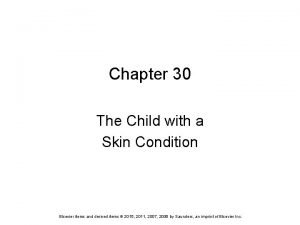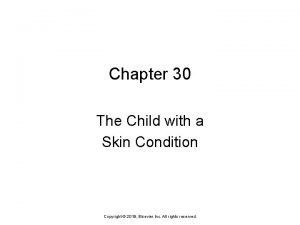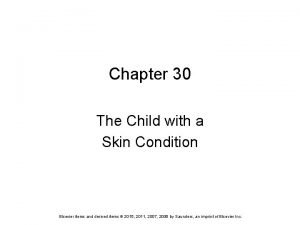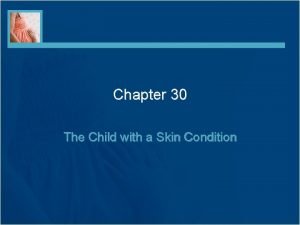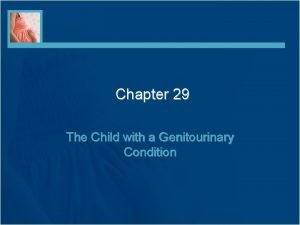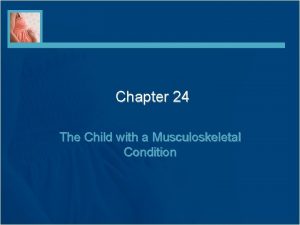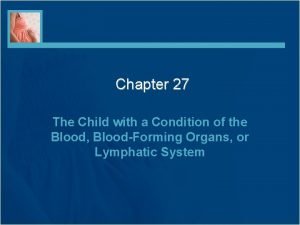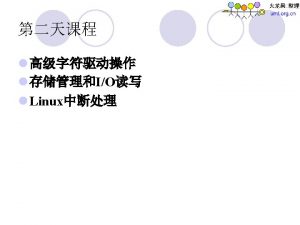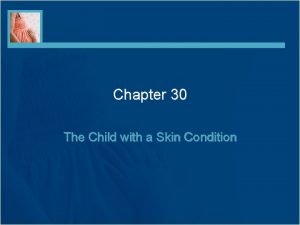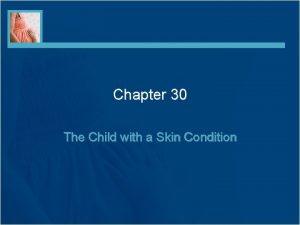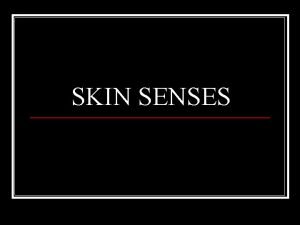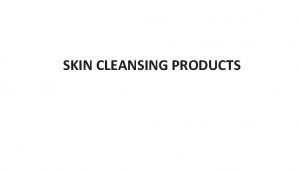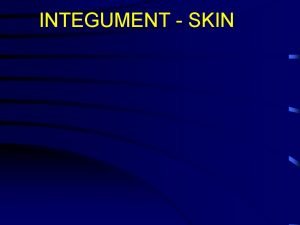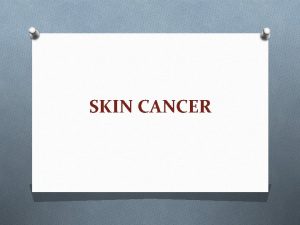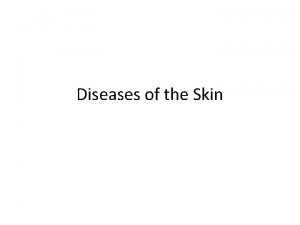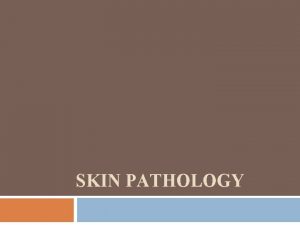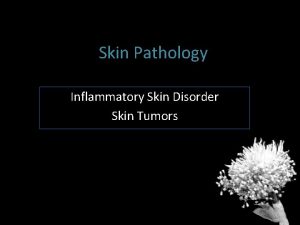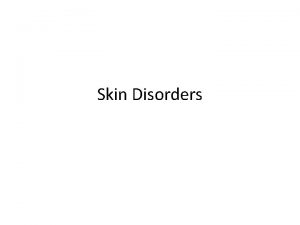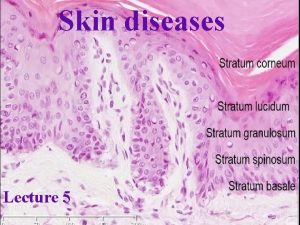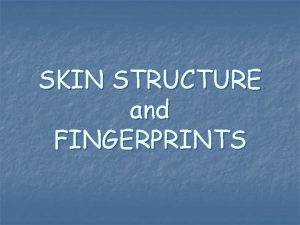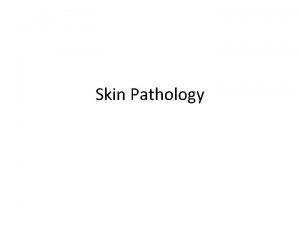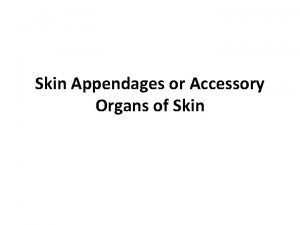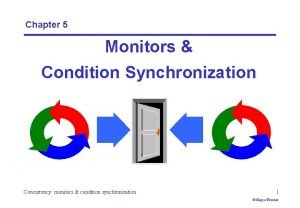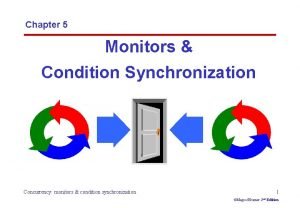Chapter 30 The Child with a Skin Condition



























- Slides: 27

Chapter 30 The Child with a Skin Condition Copyright © 2019, Elsevier Inc. All rights reserved.

Skin Development and Function Main function is protection Acts as body’s first line of defense against disease Prevents passage of harmful physical and chemical agents Prevents loss of water and electrolytes Can regenerate and repair itself Copyright © 2019, Elsevier Inc. All rights reserved. 2

Skin Disorders and Variations Skin condition may be a manifestation of a systemic disease; others may be congenital, Skin color is an important diagnostic criterion in certain diseases. Skin tests can be used to diagnose allergies. Hair is inspected for color, texture, quality, distribution, and elasticity. Condition of hair can change based on nutrition or disease status. Ø Hair can change because of medications or medical treatments. Ø Copyright © 2019, Elsevier Inc. All rights reserved. 3

Strawberry nevus A common hemangioma Usually harmless and painless, but causes a lot of distress for parents May disappear spontaneously by age 5 Copyright © 2019, Elsevier Inc. All rights reserved. 4

Skin Manifestations of Illness Café au lait macules Light brown, oval patches Ø Multiple macules are associated with neurofibromatosis (a chromosomal abnormality) and tuberous sclerosis. Ø Hypopigmented macules Whitish oval or leaf shaped Ø Multiple macules associated with tuberous sclerosis Ø Copyright © 2019, Elsevier Inc. All rights reserved. 5

Skin Infections Miliaria Intertrigo Seborrheic dermatitis Diaper dermatitis Acne Vulgaris Herpes simplex, type I Copyright © 2019, Elsevier Inc. All rights reserved. 6

Infantile Eczema Atopic dermatitis is an inflammation of genetically hypersensitive skin. Ø Local vasodilation in affected areas Spongiosis or breakdown of dermal cells and formation of intradermal vesicles Rarely seen in breastfed infants until they begin to eat additional food Ø It is a symptom rather than a disorder. Ø Infant is oversensitive to certain substances. Ø Worse in winter Copyright © 2019, Elsevier Inc. All rights reserved. 7

Parent Teaching (1 of 2) Ointments should be completely washed off between applications. Cortisone creams should be avoided because they do not resolve the underlying cause. Copyright © 2019, Elsevier Inc. All rights reserved. 8

Parent Teaching (2 of 2) How to apply topical medications Best absorbed after a warm bath Ø Applied by stroking in direction of hair growth Ø Use proper amount of ointment. Ø Elbow restraints can prevent an infant from scratching while allowing freedom of movement. . Ø Topical steroids should not be used when a viral infection is present. Ø Copyright © 2019, Elsevier Inc. All rights reserved. 9

Staphylococcal Infection Primary infection may develop in a newborn in the umbilicus or circumcision wound. May occur while in hospital or after discharge Infection may enter bloodstream, leading to septicemia. Small pustules on a newborn must be reported immediately. Antibiotic ointments are used in some situations; in others, intravenous antibiotics are required. If an infant has MRSA, the child is placed in contact isolation if hospitalized. Copyright © 2019, Elsevier Inc. All rights reserved. 10

Scalded Skin Syndrome Caused by Staphylococcus aureus Lesions begin with a mild erythema with a sandpaper texture. Vesicles appear, and rupture and peeling occur, exposing a bright-red surface. Skin appears scalded, and child abuse is often suspected. Generally heals without scarring Copyright © 2019, Elsevier Inc. All rights reserved. 11

Impetigo Caused by staphylococci or group A betahemolytic streptococci Bullous form seen in infants usually staphylococcal Ø Nonbullous form seen in children and young adults Ø Newborns susceptible because resistance to skin bacteria is low Ø Very contagious Treatment is either oral or parenteral antibiotics Copyright © 2019, Elsevier Inc. All rights reserved. 12

Fungal Infections Invade stratum corneum, hair, and nails Fungi are larger than bacteria Tinea capitis—alopecia Tinea corporis—oval scaly inflamed ring with clear center Tinea pedis—lesions are between toes, on instep and soles; pruritic Tinea cruris—“jock itch” Copyright © 2019, Elsevier Inc. All rights reserved. 13

Pediculosis Three types Pediculosis capitis—head lice Ø Pediculosis corporis—body lice Ø Pediculosis pubis—pubic lice, known as crabs Ø Survival of lice depends on blood extracted from infected person. Very contagious Can be cured with OTC shampoos, such as Kwell or Nix Copyright © 2019, Elsevier Inc. All rights reserved. 14

Scabies Parasitic Caused by female mite Burrows under skin and lays eggs, especially between fingers Ø Burrows contain eggs and feces Ø Itching is intense, especially at night Thrives in moist body folds Spread by close personal contact Treatment is the application of permethrin. All family members and the home and car require treatment. Copyright © 2019, Elsevier Inc. All rights reserved. 15

Burns Types of burns include Thermal—caused by fire or scalding vapor or liquid Ø Chemical—caused by corrosive powder or liquid Ø Electrical—caused by electrical current passing through the body Ø Radiation—caused by x-rays or radioactive substances Ø Copyright © 2019, Elsevier Inc. All rights reserved. 16

Children’s Response to Burns Skin is thinner, leading to more serious depth of burn with lower temperatures and shorter exposures. Immature response systems in young children cause shock and heart failure. Large body surface area of child results in greater fluid, electrolyte, and heat loss. Increased BMR results in increased protein and calorie needs. Copyright © 2019, Elsevier Inc. All rights reserved. 17

Types of Burns Moderate Partial-thickness burns involving 15% to 30% of body surface Ø Full-thickness burns involving less than 10% of body surface Ø Major Partial-thickness involving 30% or more of body surface Ø Full-thickness burns involving 10% or more of body surface Ø Both types are considered open wounds that have the added danger of infection. Copyright © 2019, Elsevier Inc. All rights reserved. 18

The 6 Cs of Burn Care Clothing Cooling Cleaning Chemoprophylaxis Covering Comforting (pain relief) Copyright © 2019, Elsevier Inc. All rights reserved. 19

Electrical Burn Child should be assessed for entry and exit lesions. Indicates path of electricity through the body Muscle damage can occur. Copyright © 2019, Elsevier Inc. All rights reserved. 20

Emergency Care of Burns Stop the burning process. Evaluate the injury. Cover the burn. Transport to hospital. Copyright © 2019, Elsevier Inc. All rights reserved. 21

Emergency Care Establish an airway. Cyanosis, singed nasal hair, charred lips, and stridor are indications that flames may have been inhaled. Ø An endotracheal tube may be inserted to protect the airway. Ø Establish an intravenous line. Obtain blood and other body fluids for laboratory testing. A nasogastric tube may be inserted to empty stomach and prevent complications. Copyright © 2019, Elsevier Inc. All rights reserved. 22

Wound Care Can be painful; pain medications should be given in advance of the treatments to ensure adequate pain control is achieved. Cleansing and débridement Loss of skin increases threat of infection and fluid loss caused by evaporation can be significant. Copyright © 2019, Elsevier Inc. All rights reserved. 23

Nursing Care Protective isolation is instituted. All instruments are sterile. Ointments are applied with a sterile gloved hand or sterile tongue depressor. Care must be taken to avoid injury to granulating tissue. Copyright © 2019, Elsevier Inc. All rights reserved. 24

Sunburn Common skin injury caused by overexposure to sun Can be minor epidermal burn to serious partial-thickness burn with blisters Goal of treatment Stop exposure. Ø Treat inflammation. Ø Rehydrate skin. Ø Copyright © 2019, Elsevier Inc. All rights reserved. 25

Sunscreen and Sunblock Sunscreen Topical partially absorbs UV light Ø Have an SPF rating to evaluate effectiveness in blocking sun rays Ø Sunblock Reflects sunlight Ø Zinc oxide and titanium dioxide are effective. Ø Copyright © 2019, Elsevier Inc. All rights reserved. 26

Frostbite Results from freezing of a body part Chilblain: a cold injury with erythema and formation of vesicles and ulcerative lesions that occur as a result of vasoconstriction Ø In exposure to extreme cold, warmth is lost in the periphery of the body before the core temperature drops. Ø In extreme cases, the head and torso should be warmed before the extremities to ensure survival. Ø A deep purple flush appears with the return of sensation, which is accompanied by extreme pain. Can result in necrosis and may require amputation of the affected extremity Copyright © 2019, Elsevier Inc. All rights reserved. 27
 Chapter 30 the child with a skin condition
Chapter 30 the child with a skin condition Chapter 30 the child with a skin condition
Chapter 30 the child with a skin condition Chapter 30 the child with a skin condition
Chapter 30 the child with a skin condition Chapter 30 the child with a skin condition
Chapter 30 the child with a skin condition Chapter 29 the child with a genitourinary condition
Chapter 29 the child with a genitourinary condition Chapter 29 the child with a genitourinary condition
Chapter 29 the child with a genitourinary condition Chapter 24 the child with a musculoskeletal condition
Chapter 24 the child with a musculoskeletal condition Chapter 27 the child with a condition of the blood
Chapter 27 the child with a condition of the blood Datum shift
Datum shift Skin is the largest organ
Skin is the largest organ Thin skin vs thick skin
Thin skin vs thick skin Milady facial massage steps
Milady facial massage steps Left child right sibling tree
Left child right sibling tree Hát kết hợp bộ gõ cơ thể
Hát kết hợp bộ gõ cơ thể Ng-html
Ng-html Bổ thể
Bổ thể Tỉ lệ cơ thể trẻ em
Tỉ lệ cơ thể trẻ em Chó sói
Chó sói Tư thế worm breton là gì
Tư thế worm breton là gì Bài hát chúa yêu trần thế alleluia
Bài hát chúa yêu trần thế alleluia Các môn thể thao bắt đầu bằng tiếng đua
Các môn thể thao bắt đầu bằng tiếng đua Thế nào là hệ số cao nhất
Thế nào là hệ số cao nhất Các châu lục và đại dương trên thế giới
Các châu lục và đại dương trên thế giới Công của trọng lực
Công của trọng lực Trời xanh đây là của chúng ta thể thơ
Trời xanh đây là của chúng ta thể thơ Cách giải mật thư tọa độ
Cách giải mật thư tọa độ Phép trừ bù
Phép trừ bù độ dài liên kết
độ dài liên kết
